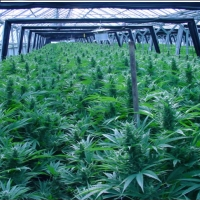Size of California Marijuana Crop Obscured by a Haze of Contradictory Data

It has been an article of faith among proponents of legalized marijuana in California that it makes economic sense to decriminalize and tax the weed because, after all, it is the largest cash crop in the state.
However, researchers from UCLA, RAND Corp., Pepperdine University and Carnegie Mellon University have published a book that raises the question: What are those folks smoking?
The book, Marijuana Legalization: What Everyone Needs to Know, focuses on national growth and consumption of the crop, but since California is the acknowledged top marijuana producer in the country, its findings are directly applicable. Marijuana doesn’t even make the book’s Top 5 crops and the authors say it might not even deserve a spot in the Top 15.
The U.S. Department of Agriculture ranked grapes ($3.2 billion) as California’s top crop in 2010, followed by almonds ($2.8 billion), strawberries ($1.8 billion) and lettuce ($1.6 billion). But, by extrapolating the book’s estimate of the entire national marijuana crop ($2.1 billion – $4.3 billion) and assuming a healthy California percentage of the market below 40%, one comes up with a Golden State pot ranking somewhat closer to potatoes way down the list.
California marijuana would have to have a 75% share of a $4 billion market to be the state’s top cash crop, based on the authors’ data.
Of course, no one really knows how much marijuana is being grown anywhere in the country. And what little anyone did know has been clouded by recent federal crackdowns on medical marijuana.
A 2006 study by Jon Gettman, a columnist at High Times, claimed that marijuana was not only the top cash crop in the country, it was the top crop in 12 states, one of the top three crops in 30 states and one of the top five crops in 39 states. And this was despite federal eradication programs that put thousands of cultivation sites out of business every year.
Gettman estimated that national marijuana production had an annual value of $35.8 billion, more than corn and wheat combined. He put California’s share of the market at around 39%, or $13.8 billion. That’s at least three times as high as the new marijuana study’s entire national crop.
The new book, acknowledging the influence Gettman’s book has had on the debate, singles it out for criticism and notes “differences of opinion” with it on key factors like what constitutes a joint and what percentage of marijuana consumed is domestically produced.
Probably with Gettman in mind, the book lacerates analysts who compare the retail price of marijuana to the “farm-gate price” of other products, pretend that all marijuana consumed in the U.S. is sinsemilla, don’t admit that most marijuana used in the country is imported, and use “implausible estimates of U.S. production.”
While the book’s authors may have been wondering what Gettman was smoking when he wrote his report, Gettman similarly questions their expertise.
“Non-using analysts are woefully ignorant about marijuana consumption amounts or practices,” Gettman wrote in an email to The Bay Citizen, defending his report, which he said was based on a number of government sources, including the Office of National Drug Control Policy.
–Ken Broder
To Learn More:
New Book Discounts Theory of Marijuana as Top US Cash Crop (by Michael Montgomery, The Bay Citizen)
Marijuana Production in the United States (2006) (by Jon Gettman) (pdf)
California’s Top 10 Cash Crops (NORML)
Review – Marijuana Legalization: What Everyone Needs to Know, Part 1 (by Pete Guither, Drug WarRant)
- Top Stories
- Controversies
- Where is the Money Going?
- California and the Nation
- Appointments and Resignations
- Unusual News
- Latest News
- California Forbids U.S. Immigration Agents from Pretending to be Police
- California Lawmakers Urged to Strip “Self-Dealing” Tax Board of Its Duties
- Big Oil’s Grip on California
- Santa Cruz Police See Homeland Security Betrayal in Use of Gang Roundup as Cover for Immigration Raid
- Oil Companies Face Deadline to Stop Polluting California Groundwater





